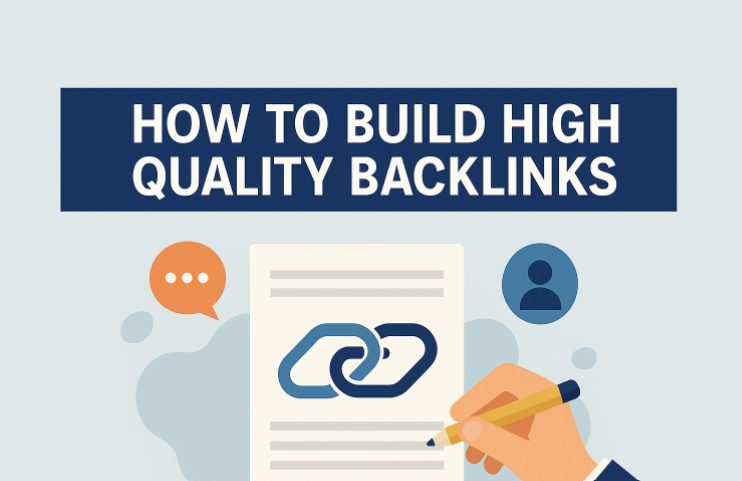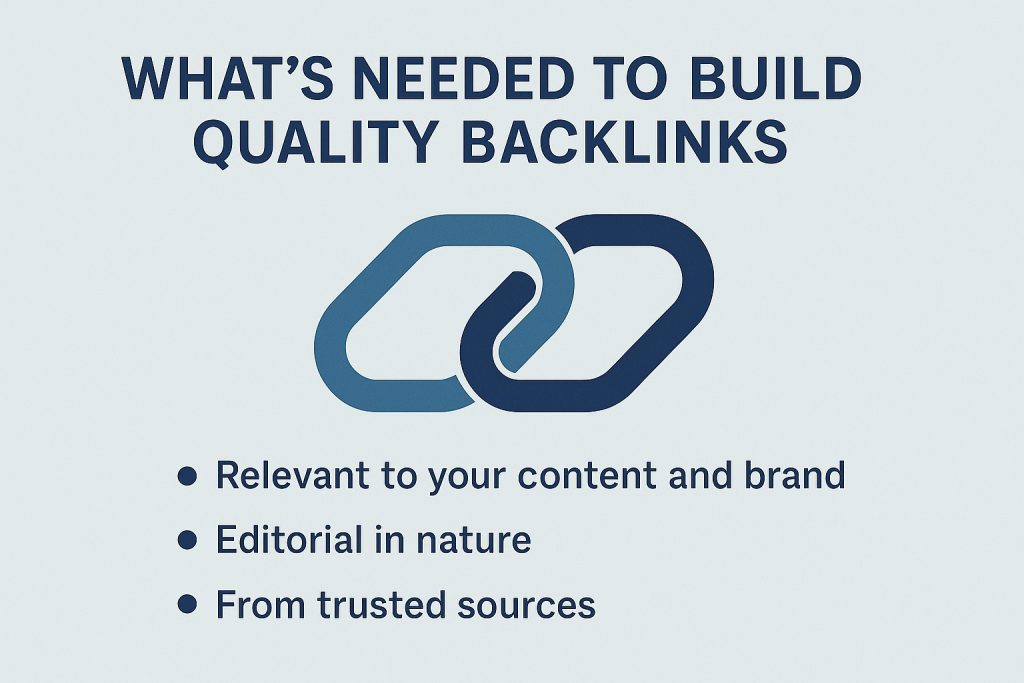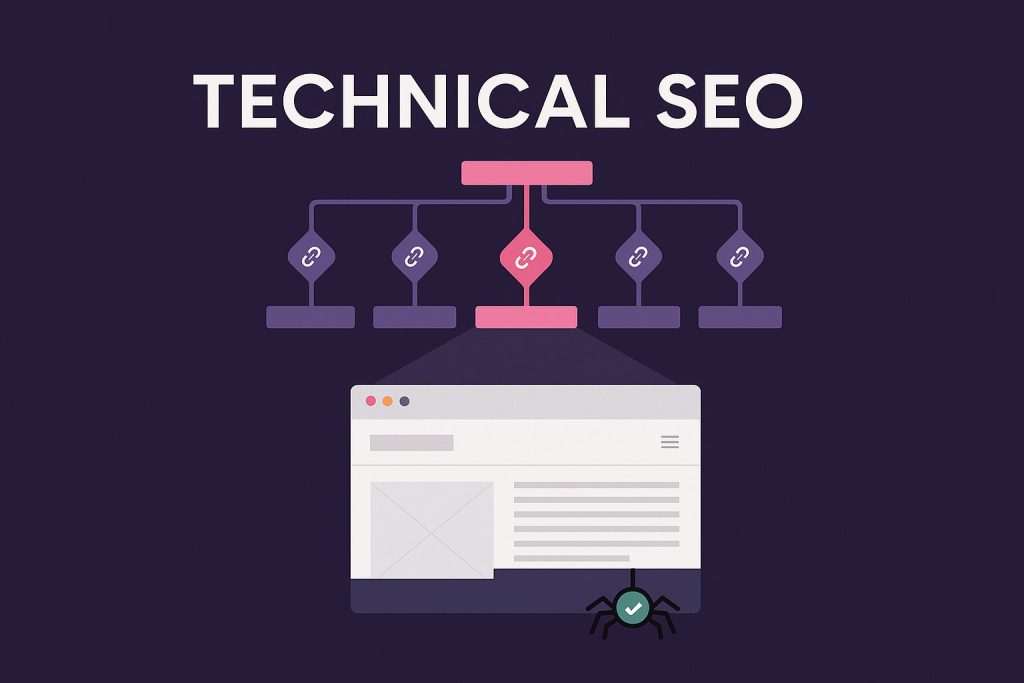You will learn how to build high quality backlinks in the digital age of AI.
Not just links, but strategies focused on building the kind of authority and trust that elevate your website’s position and topical relevance. In today’s fast-changing SEO landscape, a strong backlink profile remains essential, not just for search rankings, but for gaining topical authority and credibility in your niche.
Gone are the days when any link could move the needle; it’s now about quality, relevance, and genuine trust.
In this guide, you’ll discover the most effective, AI-ready strategies for building backlinks that truly matter. We’ll cover proven approaches that increase your site’s authority and building brand awareness is important to get quality links, drive meaningful referral traffic, and help you earn both website and topical trust.

Whether you’re looking to boost rankings, attract the right audience, or cement your reputation, this comprehensive toolkit will show you how to build high quality backlinks that deliver real results.
We will explore proven methods that not only boost your search rankings but also drive relevant referral traffic and establish your brand as an authority in its niche.
From creating link to high quality content to strategic outreach and leveraging existing relationships, you will gain a comprehensive toolkit to build high quality backlinks that stand the test of time.
Understanding High Quality Backlinks
Before diving into the strategies, it’s crucial to define what makes a backlink “high quality.” A high-quality backlink has several key attributes that search engines use to evaluate its value. Understanding complete seo guide characteristics will help you focus your efforts on acquiring links that provide the most significant SEO impact.
Key Characteristics of a Quality Backlink
- Relevance: The most valuable backlinks come from websites and content that are topically related to your own. A link from a leading marketing blog to your article about social media analytics is far more powerful than a link from an unrelated site about pet grooming.
- Authority: Links from well-established, trusted, and authoritative websites carry more weight. You can gauge a site’s authority using metrics like Domain Rating (DR) or Domain Authority (DA), but also consider its real-world reputation, traffic, and influence.
- Trustworthiness: Search engines favor links from trustworthy sources. A link from a reputable news organization, a .gov or .edu domain, or a respected industry publication is a strong signal of trust.
- Placement: The position of a link on a page matters. A contextual link placed within the main body of the content, surrounded by relevant text, is more valuable than a link buried in a footer or a sidebar directory.
- Anchor Text: The clickable text of a link, or anchor text, provides context to both users and search engines. Natural, relevant anchor text (e.g., “social media marketing guide“) is generally better than generic text (“click here”).
Now that we have a clear picture of what we’re aiming for, let’s explore the actionable strategies you can use to build high quality backlinks.
Why Building Backlinks Is Important?
Backlinks are a fundamental pillar of SEO and play a vital role in the success of any website.
They serve as endorsements from other sites, signaling to search engines that your content is trustworthy, relevant, and authoritative. When high-quality websites link to your pages, it boosts your site’s credibility in the eyes of search engines like Google.
This increased authority can lead to higher search rankings, making it easier for potential visitors to discover your content.
Low-quality or spammy backlinks can damage your SEO performance and weaken your online reputation. To achieve sustainable growth, focus on earning editorial, niche-relevant, and authoritative backlinks that align with your brand and add genuine value to your content some of the tactics also you can follow to gain free quality backlinks from different websites. These high-quality links help you:
- Drive targeted referral traffic from credible sources
- Increase brand authority, trust, and online visibility
- Improve domain authority and achieve higher search engine rankings
The Quality vs Quantity Backlinks: Arguments
A common question in SEO circles is, “How many backlinks do I need to rank?”
While it’s tempting to chase high numbers, the truth is that one high-quality backlink from a trusted, authoritative site can be far more valuable than dozens of low-quality links. Gone are the days when amassing thousands of backlinks would easily propel you to the top of Google. Today, search engines are much more sophisticated, evaluating the trust, relevance, and context of every link.
Focus on building backlinks that deliver genuine value, and those placed on reputable websites relevant to your industry. These links not only support your SEO growth but also help establish your website as a trusted resource in your field.
While there isn’t a “magic number” of backlinks required to rank, prioritizing quality over sheer quantity will yield better, longer-lasting results for your site’s authority and search performance.
Build High Quality Backlinks for SEO Dominance
Beyond just rankings, backlinks drive direct referral traffic from other trusted sources. They help expand your reach to new audiences and foster connections within your industry. In today’s digital environment, where trust and topical authority are more important than ever, building strong backlinks not only supports your SEO objectives but also helps solidify your website as a go-to resource in your niche.
1. Create Link-Worthy Content (Link Bait)
The foundation of any successful link building campaign is having content that people want to link to. You can have the best outreach strategy in the world, but if your content is mediocre, your efforts will fall flat. “Link-worthy” content, often called “link bait,” is content created with the specific intention of attracting backlinks naturally.
Types of Link-Worthy Content
- Ultimate Guides & In-Depth Tutorials: Comprehensive resources that cover a topic in exhaustive detail become the go-to reference for that subject. People will link to your guide as a source of authoritative information for their own readers. Think of a 5,000-word guide on “Getting Started with Python” or “The Complete Guide to Container Gardening.”
- Original Research & Data Studies: Conducting your own research, surveys, or data analysis positions you as a primary source of information. Bloggers, journalists, and other creators will link to your study when they cite your findings. For example, a marketing agency might survey 1,000 consumers about their online shopping habits and publish the results.
- Free Tools & Calculators: Developing a useful, free tool can be a powerful magnet for backlinks. If you can solve a common problem for your audience, they will link to your tool repeatedly. Examples include mortgage calculators, headline analyzers, or website speed testers. This is a highly effective way to build high quality backlinks over the long term.
- Visually Appealing Infographics: Infographics distill complex information into a visually engaging and easily shareable format. Their visual nature makes them perfect for being embedded in other blog posts, with a mandatory link back to your site as the source.
- Expert Roundups: Compile insights and quotes from multiple experts on a specific topic. The experts you feature will likely share the content with their own audiences and link to it from their websites, creating a powerful network effect.
Creating this type of content requires a significant investment of time and resources, but the payoff in terms of high-quality, organic backlinks is unparalleled. The key is to produce the best possible resource on a given topic.
2. Master the Art of Guest Posting
Guest posting, or guest blogging, is a time-tested strategy to build high quality backlinks. The process involves writing and publishing an article on another website in your industry. In return for the valuable content, the site owner typically allows you to include a link back to your own website within the author bio or sometimes contextually within the article itself.
What’s needed to build quality backlinks for your niche?

How to Succeed with Guest Posting
- Identify High-Quality Targets: Look for reputable blogs and publications in your niche that accept guest contributions. Use search queries like
[your industry] + "write for us"or[your topic] + "guest post guidelines". Prioritize sites with strong authority, an engaged audience, and a clear editorial process. - Develop a Personalized Pitch: Generic, mass-emailed pitches rarely work. Before reaching out, study the blog to understand its tone, audience, and the type of content it publishes. Your pitch should be concise, demonstrate that you’ve done your homework, and propose a few unique, compelling article ideas that would resonate with their readers.
- Write Exceptional Content: Once your pitch is accepted, your job is to deliver an outstanding article. Don’t treat it as a second-class piece of content. Write your best work, follow all of the site’s guidelines, and provide genuine value to their audience. This builds a strong relationship and increases the chances of future collaborations.
- Place Your Link Strategically: The most valuable link is a contextual one that fits naturally into the flow of the article. If the site only allows a link in the author bio, make sure your bio is compelling and clearly directs people to a relevant page on your site.
Guest posting is about more than just the link; it’s about building relationships, expanding your reach, and establishing yourself as an authority.
3. The Skyscraper Technique
The Skyscraper Technique, popularized by Brian Dean of Backlinko, is a systematic method to build high quality backlinks by improving upon existing popular content. It’s a smart way to create something you already know has the potential to attract links.
The Three Steps of the Skyscraper Technique
- Find Link-Worthy Content: The first step is to find a piece of content in your niche that has already generated a lot of backlinks. You can use SEO tools like Ahrefs or Semrush to search for a relevant keyword and identify the top-ranking pages. Analyze these pages to see how many domains are linking to them.
- Make Something Even Better: Once you’ve identified a popular piece of content, your goal is to create a resource that is significantly better. You can improve upon it by making it:
- More Thorough: Add more details, steps, or examples. If the original post had “10 Tips,” create a post with “25 Ultimate Tips.”
- More Up-to-Date: Update outdated information, stats, or screenshots.
- Better Designed: Create a more visually appealing and user-friendly layout. Add custom graphics, videos, or an interactive element.
- Reach Out to the Right People: This is the crucial step. Use your SEO tool to get a list of all the websites that linked to the original, inferior piece of content. Reach out to them with a personalized email. Let them know you saw they linked to the original resource, and mention that you’ve created a more comprehensive and up-to-date version. Politely suggest they might consider adding or replacing the old link with a link to your superior resource.
This technique is effective because you are targeting an audience that has already shown interest in your topic by linking to similar content.
4. Broken Link Building
Broken link building is a highly effective and mutually beneficial strategy. It involves finding broken (dead) links on other websites, creating content that can replace the dead resource, and then notifying the site owner so they can fix the broken link by linking to your content instead.
The Broken Link Building Process
- Find Broken Links on Relevant Websites: You need to prospect for broken links on authoritative sites in your industry. You can do this by:
- Using browser extensions like Check My Links to scan a specific page for dead links.
- Targeting resource pages. Use search queries like
[your industry] + "resources"or[your topic] + "useful links". These pages often contain outdated links. - Using SEO tools like Ahrefs’ Site Explorer to find a competitor’s site and check its “Broken backlinks” report. This shows you sites that are linking to pages that no longer exist.
- Create or Identify a Replacement Resource: Once you find a broken link, see what the original content was about using the Wayback Machine. If you have an existing article, guide, or tool that serves as a perfect replacement, you’re ready for the next step. If not, you can create a new piece of content specifically designed to be a superior replacement for the dead resource.
- Conduct Outreach: Reach out to the webmaster of the site with the broken link. Your email should be friendly and helpful. Start by introducing yourself and letting them know you’ve found a broken link on their page. Provide the exact location of the dead link. Then, as a helpful suggestion, offer your own content as a replacement.
Because you are providing value first by helping the site owner fix an issue on their site, the conversion rate for this type of outreach is often much higher than for other methods. It’s a win-win scenario that allows you to build high quality backlinks.
5. Leverage Digital PR and Media Outreach
Digital PR focuses on getting your brand mentioned in online publications, news articles, and high-authority blogs. While the primary goal might be brand awareness, these mentions almost always come with a powerful backlink. This strategy is about creating newsworthy stories, data, and content that journalists and publishers want to cover.
How to Use Digital PR for Backlinks
- Publish Original Data and Studies: As mentioned earlier, journalists love data. If you can publish a compelling study with surprising findings related to your industry, you can pitch this story to relevant journalists. A headline like “New Study Finds 75% of Remote Workers Suffer from Burnout” is highly newsworthy.
- Create Newsworthy Assets: Think beyond studies. You can create compelling infographics, interactive maps, or unique trend reports that tell a story. The key is to create something a publication would want to feature to make their own articles more engaging.
- Newsjacking: This involves capitalizing on current news stories to insert your brand’s perspective. If there’s a major development in your industry, you can quickly publish a reaction piece or expert commentary and pitch it to journalists who are covering the story. This requires speed and relevance.
- Help a Reporter Out (HARO): HARO is a free service that connects journalists with sources for their stories. You can subscribe to receive daily emails with queries from reporters. By providing a timely, expert quote or piece of information, you can earn a mention and a backlink from major publications like Forbes, The New York Times, and more.
Digital PR requires creativity and a strong understanding of what makes a good story, but it can land you some of the most authoritative and valuable backlinks possible.
6. Unlinked Brand Mentions
An unlinked brand mention occurs when a website writes about your company, brand, or product but doesn’t include a link back to your site. These are low-hanging fruit for link building because the author is already familiar with and talking about you. Your job is simply to ask them to make that mention a clickable link.
How to Find and Claim Unlinked Mentions
- Set Up Alerts: Use tools like Google Alerts, BuzzSumo, or Ahrefs Alerts to monitor the web for mentions of your brand name, product names, or even the names of key people in your company. Set up daily or weekly email digests.
- Review Your Mentions: Periodically go through the alerts to find articles and posts that mention you. Check each one to see if the mention includes a link.
- Reach Out and Request the Link: For any unlinked mentions, send a polite and friendly email to the author or editor of the site. Thank them for mentioning your brand. Then, kindly ask if they would consider adding a link to the mention. Explain that it would help their readers easily find more information.
This is one of the easiest and most effective ways to build high quality backlinks because the hard part of getting mentioned is already done. The request is small and logical, leading to a high success rate.
Writing a Compelling Pitch to Secure Backlinks
Crafting a successful outreach pitch is both an art and a science. Your ability to earn a guest posts or any high-authority backlink always depends on how well you communicate value, relevance, and a personal touch. Remember, editors and website owners are constantly bombarded with generic requests that quickly get sent to the trash. To break through the noise, your pitch needs to demonstrate not only your respect for their time but also your understanding of their brand and audience.
Begin by thoroughly researching the target site: read their latest posts, understand their content gaps, and familiarize yourself with their readership and tone. Next, position your pitch as an offer of genuine value, making it clear that your goal is to help enhance their site, not just promote your own.
See the Examples
Hi [Name],
Let’s Bring Something big together in near future!
I came across your website and really enjoyed your recent post on [Topic]. I believe a collaboration could add value to both our audiences. Would you be open to a guest post collaboration partnership? Let me know your thoughts — I’d love to discuss further!
This type of outreach combines relevance, credibility, and perfect timing with the very elements that make backlinks powerful and meaningful for long-term SEO success.
Always use the recipient’s name, reference something specific about their recent content, and suggest several tailored article ideas to explaining why each would resonate with their audience. When possible, highlight your expertise and include samples of your best work to establish credibility.
Here are some key tips to make your pitch stand out:
- Research and reference recent content published on the target site
- Address the editor or blogger by name, avoiding generic greetings
- Personalize every message so it feels hand-crafted, not templated
- Keep your email brief but packed with clear, relevant information
- Suggest at least 2–3 original, relevant article ideas—with catchy headlines
- Briefly explain why each idea is a perfect fit for their audience
- Share previous guest posts or writing samples to build trust
- Highlight any unique data, insights, or expertise you bring to the table
- Show that you value their editorial guidelines and will respect them
- End with a polite thank you and a specific call-to-action (e.g., inviting a quick reply or feedback)
By following this approach, you make it easy for editors to visualize the benefit of working with you. A well-crafted, thoughtful pitch not only increases your chances of earning a backlink, but also helps start a lasting professional relationship.
Building a Sustainable Backlink Strategy
Building a strong backlink profile is a marathon, not a sprint.
The strategies outlined above is creating exceptional content, guest posting, using the Skyscraper Technique, fixing broken links, leveraging digital PR, and claiming unlinked mentions are powerful, ethical, and sustainable ways to build high quality backlinks.
The key to long-term success is consistency and a focus on providing genuine value. Don’t chase shortcuts or engage in spammy tactics that could harm your site in the long run. Instead, focus on creating great resources and building real relationships within your industry.
By doing so, you will not only improve your search engine rankings but also build a stronger, more authoritative brand that attracts both customers and valuable links naturally.
Start implementing these strategies today, and watch your website’s authority grow.
If you’re serious about building high-quality backlinks for your website or looking for a reliable expert to handle it for you ADigital can help.


